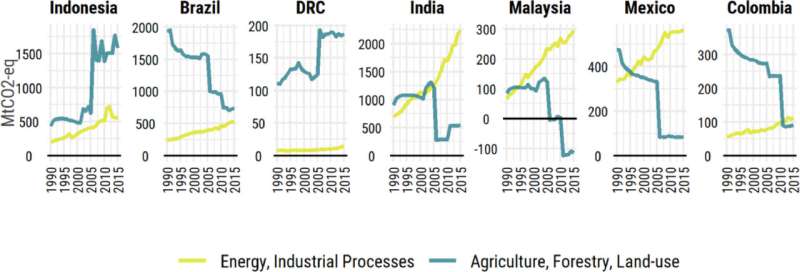This article has been reviewed according to Science X's editorial process and policies. Editors have highlighted the following attributes while ensuring the content's credibility:
fact-checked
proofread
A new approach to sharing the burden of carbon dioxide removal

To have a chance to achieve the Paris Agreement's goal of limiting global warming to 1.5–2°C compared to pre-industrial levels, it is clear that we will need to go beyond restricting emissions and actively focus on removing carbon dioxide from the atmosphere. Discussions and studies on how countries should share the burden of carbon dioxide removal are however limited, and so far, mostly only concerned developed countries and major emitters. To deliver the global targets we need to extend analysis and discussions to developing economies as well.
In a new IIASA-led study, an international team of researchers analyzed carbon dioxide removal quotas for developing countries, while considering issues of equity and fairness. The study, published in the journal Nature-Based Solutions, employs a diverse set of allocation methods on a range of global emissions scenarios to address equitability in sharing the burden of climate change mitigation.
The allocation methods were based on extended equity principles compared to previous studies, adding the right to development principle to other principles of responsibility, equality, and capacity. Based on these methods, the team distilled the global climate targets into national quotas and assessed the implications for developing countries.
Carbon dioxide removal can be achieved by either using technology and engineering methods, or through natural climate solutions, such as conservation, restoration, and improved land management. Given the large potential for natural climate solutions in tropical developing countries, the study focused on seven of these (Brazil, Colombia, Democratic Republic of Congo (DRC), India, Indonesia, Malaysia, and Mexico) which together cover ∼35% of global cost-effective natural climate solutions potential.
"The study is unique because it looks at the issue from the perspective of developing countries. Because of this, the study has a far more rigorous methodology in evaluating potential carbon dioxide removal requirements compared to previous studies," says Bintang Yuwono, co-lead author of the study and a researcher in the IIASA Biodiversity and Natural Resources Program. "The conclusions of the study point to a paradigm shift in using top-down burden-sharing approaches to inform climate change mitigation."
The researchers found that the potential for carbon dioxide removal quotas for these seven countries ranged between 0.1–29 gigatons of carbon dioxide across the allocation scenarios. The results also revealed inherent bias and strong heterogeneity of quotas between the allocation methods, making agreement on an "equitable" quota unlikely.
Moreover, the researchers also warned that if ambitious quotas are implemented in countries with vast forest areas, it might lead to competition between natural and non-nature-based solutions, to the detriment of emissions reduction, biodiversity, and the benefits that people can derive from nature. Therefore, it is important to not use these quotas to inform climate targets, but instead use the results to foster higher ambition in voluntary cooperation mechanisms.
"The research shows that fairness is not just important from an ethical perspective, but also contribute to more effective recommendations that address emission reductions from sustainable land management," says Ping Yowargana study co-lead author, and a researcher in the IIASA Biodiversity and Natural Resources Program. "Manifesting ambition should go from top-down target setting on superficial parameters such as tons of carbon dioxide towards detailed deliberation of policy measures to address more fundamental issues. This, unfortunately, still requires a lot of hard work."
More information: Bintang Yuwono et al, Doing burden-sharing right to deliver natural climate solutions for carbon dioxide removal, Nature-Based Solutions (2022). DOI: 10.1016/j.nbsj.2022.100048
Provided by International Institute for Applied Systems Analysis (IIASA)




















